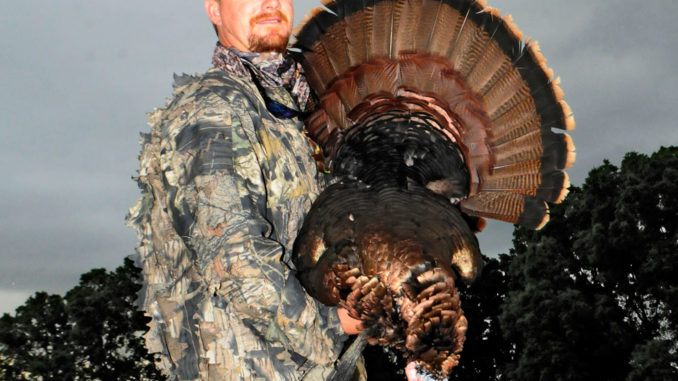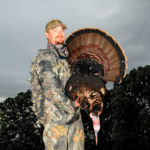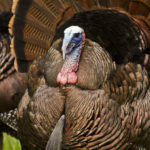
It takes a special hunter and special tactics to score on gobblers late in the season. Learn from these…
The easy gobblers are already in freezers across North Carolina. As the end of the 2013 spring season nears, it’s the tough birds that are left in the woods, the old toms that have survived several seasons by understanding that there’s somebody out there trying to fill them full of copper-plated No. 4s.
There’s one thing about turkey hunters, however. They aren’t about to give up before May 11, when the N.C. Wildlife Resources Commission says they have to give up.
So what can they do to try and fill a tag?
According to Jonathan Thompson of Mint Hill, less is more.
Thompson, who operates Deep Hollow Guide Service, said that hunters need to understand that gobblers are wary of the kind of tactics that worked during the first couple of weeks of the season, and that it takes a new tact to put a tag around a tom’s leg.
“The last two weeks of the season are when the hunting is the hardest,” said Thompson, who does most of his guiding across the state line in York County, S.C., but does a lot of his “personal” hunting in his home state. “You know he’s pretty much heard every call there is, so what you have to do is call less – just enough to make contact.
“I’ve killed a lot of birds late in the season, and a big part of my success has been learning when to call and when not to. Over-calling results in under-killing.”
By calling less, you’re not going to cause a call-shy gobbler to immediately conclude that you’re a fake hen and not the real thing. Thompson said you want to limit your calling to drawing a single response from a gobbler, then letting him do the rest.
“What I like to do is yelp twice and then purr, wait 10 or 15 minutes, then yelp three times and purr, then wait 10 or 15 minutes and call again,” said Thompson (704-299-3517). “If he gobbles, stop calling. He’s going to know where you are. You need to initiate feeding sounds – learn to rake the leaves behind you with your hand, make little feeding calls.
“The old hens nest earlier, and most of what you’ve got left are younger hens that haven’t been bred. He’s real smart; he’s looking for hens he hasn’t bred yet, and soft feeding noises are relaxing to him.”
But don’t expect him to come in gobbling his head off. That’s another late-season change that toms make.
“Just because you don’t hear him doesn’t mean he’s not coming,” he said.
Another late-season trick Thompson employs is bringing a number of different calls to the woods, reasoning that sounding like a lot of different hens – even if you’re limiting your calling – may just pique his interest enough that he’ll come in for a look.
“Pot calls, slates, crystals — they all work, because they can be soft, subtle calls,” he said. “I start to carry more different calls the later it gets in the season.”
All season, Thompson works to understand the movement patterns of gobblers on the property he’s hunting, and that becomes even more important as the season wanes, because making contact with a gobbler is often difficult. He reasons that if a gobbler has been frequenting a field or open area as a strutting zone around mid-day, he’ll continue to go there to try and attract what few unbred hens are around. Ditto places where gobblers have been dusting and getting water.
“Turkey hunting is a thinking-man’s sport,” said Thompson, who has organized the Dirty South Boys pro staff across the Carolinas and Georgia. “If you don’t plan, you won’t go out and kill a turkey. You have to know where you want to start, where you want to be from 7 to 11 (a.m.), where you want to be between 11 and 2 (p.m.), and then from 2 o’clock until dark.
“He’ll go to his strutting zone, then he’ll dust, then he’ll go back to feeding, and if you’ve got a creek bottom or any low place that holds water, from mid-day on is the time to hit those areas, because he’ll go to water before he goes to roost in the evenings. Sometimes you can catch him before he goes to roost.”
Thompson will also change what he wears into the woods to better blend in as his surroundings change.
“Camouflage is a big part of your hunting,” Thompson said. “A lot of people I hunt with wash their clothes in laundry detergent; I wash mine in scent eliminator with UV killer — ultraviolet. I know that makes a difference.
“The other thing I do is, I’ll mix up my camo – dark and light. It’s critical that you look at your surroundings and try to have your camo duplicate it. Early in the season, when the woods are just starting to turn, you can still see under the trees, so I might wear light on top and a dark bottom. Later in the season, I’ll go more to green patterns. If you’re hunting in an area with mixed pines, you might want one of the Mossy Oak patterns.”






Be the first to comment